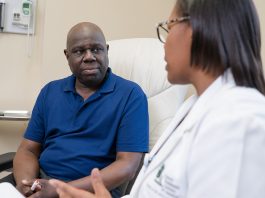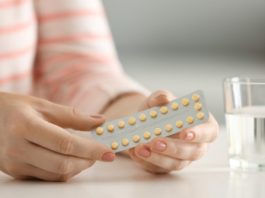How should a breast self-exam be performed?
 1) In the Shower
1) In the Shower
Using the pads of your fingers, move around your entire breast in a circular pattern moving from the outside to the center, checking the entire breast and armpit area. Check both breasts each month feeling for any lump, thickening, or hardened knot. Notice any changes and get lumps evaluated by your healthcare provider.
 2) In Front of a Mirror
2) In Front of a Mirror
Visually inspect your breasts with your arms at your sides. Next, raise your arms high overhead.
Look for any changes in the contour, any swelling, or dimpling of the skin, or changes in the nipples. Next, rest your palms on your hips and press firmly to flex your chest muscles. Left and right breasts will not exactly match—few women’s breasts do, so look for any dimpling, puckering, or changes, particularly on one side.
 3) Lying Down
3) Lying Down
When lying down, the breast tissue spreads out evenly along the chest wall. Place a pillow under your right shoulder and your right arm behind your head. Using your left hand, move the pads of your fingers around your right breast gently in small circular motions covering the entire breast area and armpit.
Use light, medium, and firm pressure. Squeeze the nipple; check for discharge and lumps. Repeat these steps for your left breast.
How breast tissue normally feels
Breasts contain tissues of varying consistency. The glandular tissue in the upper, outer part of the breast usually feels slightly rope-like, bumpy or lumpy (nodular).The surrounding fat tissue, often felt in the inner and lower parts of the breast, is soft and less nodular or lumpy than the upper, outer breast.
You might find that breast-related symptoms, such as tenderness or lumpiness, change with your menstrual cycle. Breast tissue also changes as you age, typically becoming more fatty and less dense.
When to consult your doctor
Being familiar with how your breasts normally feel makes it easier to detect when there’s a change in your breasts.
Consult your doctor if:
- You find a new breast lump
- A new breast lump or breast pain doesn’t go away after your next period
- An existing breast lump gets bigger or otherwise changes
- You notice skin changes on your breast, such as redness, crusting, dimpling or puckering
- You notice changes in your nipple — it turns inward (inversion) or appears flatter, for instance
- You notice spontaneous nipple discharge from one breast that’s clear, yellow, brown or red
What to expect during a clinical breast exam
 Evaluation of a breast lump typically begins with a clinical breast exam. During this exam, your doctor will likely:
Evaluation of a breast lump typically begins with a clinical breast exam. During this exam, your doctor will likely:
- Ask about symptoms and your risk factors for breast cancer or benign breast conditions
- Examine your breasts, noting their shape and size, while you’re standing and while you’re lying down
- Examine the skin on your breasts
- Check for nipple problems, such as inversion or discharge
- Feel (palpate) the deeper tissue in your breasts and armpits to detect lumps or areas of thickening
If your doctor confirms that you have a breast lump or other area of concern, you’ll likely need testing.
Imaging tests
To further evaluate a breast lump, your doctor might recommend one or more of the following procedures.
- A diagnostic mammogram — a specialized breast X-ray — helps your doctor investigate breast lumps and other signs and symptoms, such as tissue thickening, skin dimpling or nipple inversion.
- A diagnostic mammogram focuses on one area of your breast, providing views from several angles at higher magnification than does a screening mammogram. This test helps your doctor pinpoint the location and the size of the abnormality.
- A diagnostic mammogram is often done along with an ultrasound of the breast.
- Sound waves create images of the inside of your breast on a monitor. Ultrasound imaging is helpful for determining whether a breast lump is solid or filled with fluid.
- A magnetic field and radio waves create detailed images of the inside of your breast. A breast MRI usually is reserved for when the diagnosis is in question.
- When an MRI is used to detect breast cancer, a special dye (contrast agent) must be injected into your veins before the procedure. The dye enhances the appearance of certain tissues in the MRI images, allowing a radiologist to tell which areas are likely to be cancerous.
- MRI scans can be challenging to interpret. This can lead to a false-positive result — when the test result is positive but there’s no cancer — or the need for additional testing.
- Also called a galactogram, this test is sometimes used to find the cause of nipple discharge. A small amount of dye is injected into a duct in the nipple. The dye shows up on an X-ray and can reveal a tumor in the duct.
Breast biopsy
Sometimes removing a tissue sample to examine under a microscope (biopsy) is the only sure way to determine if a breast lump is cancer. The type of biopsy depends on the size and location of the suspicious area.
Breast biopsy options include:
- Fine-needle aspiration biopsy. With a special needle — thinner than the ones used for blood tests — your doctor withdraws (aspirates) a sample of tissue from the suspicious area.
- Core needle biopsy. Using a larger needle than is used for fine-needle aspiration, your doctor obtains a small, solid core of tissue from your breast. This type of biopsy can remove more tissue than can fine-needle aspiration. Your doctor will likely give you an injection of medicine to numb your breast before starting the biopsy.
- Stereotactic biopsy. During a stereotactic biopsy, mammography produces images from several different angles (stereo images) of the area in question. Your doctor then removes a sample of breast tissue with a needle. This test is often used to biopsy tiny calcium deposits seen only on a mammogram.
- Vacuum-assisted biopsy. After giving you an injection of numbing medication, your doctor makes a small cut (incision) in your breast to insert a hollow probe into the breast tissue. The probe connects to a vacuum that’s used to remove a tissue sample. This type of biopsy can remove tissue from more than one area through a single incision.
- Surgical biopsy. In this procedure, a surgeon cuts open your breast to remove part of the lump (incisional biopsy) or the entire breast lump plus a small amount of surrounding tissue (excisional biopsy). This type of biopsy usually is done using medication to numb your breast and possibly medication to make you sleepy or general anesthesia in an outpatient facility.
All biopsies can cause bruising, bleeding and swelling. A surgical biopsy will likely leave a scar, and depending on how much tissue is removed, may change the shape of your breast.
After a biopsy, the tissue sample is sent to a lab for analysis. Your doctor will let you know when to expect the test results and discuss the results with you when they’re available.
Follow-up after breast lump evaluation
If the breast lump isn’t cancerous, your doctor might suggest short-term monitoring followed by another clinical breast exam or repeat breast imaging in a few months to reassess the area. Consult your doctor if you notice changes in the lump or develop new areas of concern.
If the diagnosis is in question — the clinical breast exam and the mammogram show areas of suspicion, for example, but the pathology report from the biopsy reveals benign tissue — you’ll be referred to a surgeon or other specialist for further consultation.
If the breast lump is cancerous, you’ll work with your doctor to create a treatment plan. The stage and type of breast cancer will influence your treatment options. If you’re unsure how to proceed, ask your doctor to help you make the best treatment decisions.



